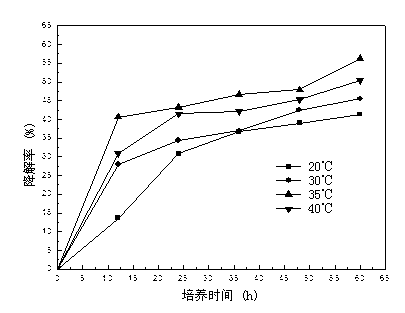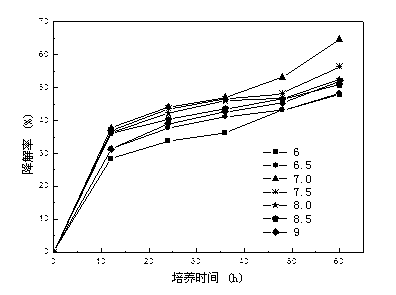Dibutyl phthalate degrading bacteria and application of dibutyl phthalate degrading bacteria
A technology of dibutyl phthalate and degrading bacteria, which is applied in the field of bioaugmentation of environmental pollutants, can solve the problems of low degradation efficiency of dibutyl phthalate, achieve good application prospects, high-efficiency degradation, and good biological The effect of enhancing the effect
- Summary
- Abstract
- Description
- Claims
- Application Information
AI Technical Summary
Problems solved by technology
Method used
Image
Examples
Embodiment 1
[0022] Example 1: Elizabeth Kingia Isolation, purification, identification and degradation characteristics of sp. D8 to DBP
[0023] 1. Isolation and purification of strains
[0024] (1) Source of bacteria
[0025] The source of the bacteria came from the activated sludge in the sewage treatment plant of Wuhan Branch of China Petroleum & Chemical Corporation.
[0026] (2) Isolation and purification of strains
[0027] Put the collected samples in a refrigerator at 4°C and inoculate 1 mL of the supernatant into 100 mL of sterilized LB medium (1 wt% peptone, 1 wt% sodium chloride, 0.5 wt% yeast extract). 30°C, 150r / min activation culture overnight. Then transfer 1 mL of the bacterial solution to the inorganic salt medium containing 200 mg / L DBP, acclimatize and cultivate for 2 days under the same conditions, gradually increase the concentration of DBP (400 mg / L, 600 mg / L, 800 mg / L , 1000 mg / L, 2000 mg / L). After the acclimatization is over, the bacteria solution is divi...
Embodiment 2
[0040] Example 2: environmental conditions Elizabeth Kingia Effect of sp. D8 degradability
[0041] 1. The influence of culture temperature
[0042] When the pH is 7.0, the shaker speed is 150 r / min and the inoculum size is 2 vol %, the effect of temperature on the degradation of DBP is as follows: figure 2 Shown: In the range of 20-40 ℃, the strain D8 has a better degradation effect on DBP, indicating that the strain has a wider adaptability to temperature. When the temperature is between 20 and 35°C, the degradation rate of the substrate increases as the temperature increases; but when the temperature reaches 40°C, the degradation rate of the substrate by strain D8 is lower than that at 35°C . show Elizabeth Kingia The optimum temperature for sp. D8 is 35°C.
[0043] 2. The influence of initial pH
[0044] When the temperature was 30°C, the rotation speed of the shaker was 150 r / min, and the inoculum size was 2 vol%, the effect of pH on the degradation of DBP wa...
Embodiment 3
[0049] Example 3: Elizabeth Kingia Sp.D8 enhanced treatment of refinery wastewater with higher concentration of DBP added
[0050] In the Erlenmeyer flask, the strain D8 was added to the activated sludge of Wuhan Petrochemical, and three groups of experiments were set up to investigate its removal effect on DBP:
[0051] (a) 30mL of oil refinery wastewater+33mL of DBP inorganic salt medium+400mg / L of DBP+30mL of activated sludge+7 vol% D8 bacterial suspension;
[0052] (b) 30mL of oil refinery wastewater+33mL of DBP inorganic salt medium+400mg / L of DBP+30mL of activated sludge after autoclaving+7 vol % of the D8 bacterial suspension;
[0053] (c) 30mL of refinery wastewater + 40mL of DBP inorganic salt medium + 400mg / L of DBP + 30mL of activated sludge.
[0054] Incubate on a shaker at 35°C and 150 rpm. At regular intervals, measure the residual concentration of DBP in the culture medium, such as Figure 6 As shown, the results show that: Elizabeth Kingia The activa...
PUM
 Login to View More
Login to View More Abstract
Description
Claims
Application Information
 Login to View More
Login to View More - R&D
- Intellectual Property
- Life Sciences
- Materials
- Tech Scout
- Unparalleled Data Quality
- Higher Quality Content
- 60% Fewer Hallucinations
Browse by: Latest US Patents, China's latest patents, Technical Efficacy Thesaurus, Application Domain, Technology Topic, Popular Technical Reports.
© 2025 PatSnap. All rights reserved.Legal|Privacy policy|Modern Slavery Act Transparency Statement|Sitemap|About US| Contact US: help@patsnap.com



